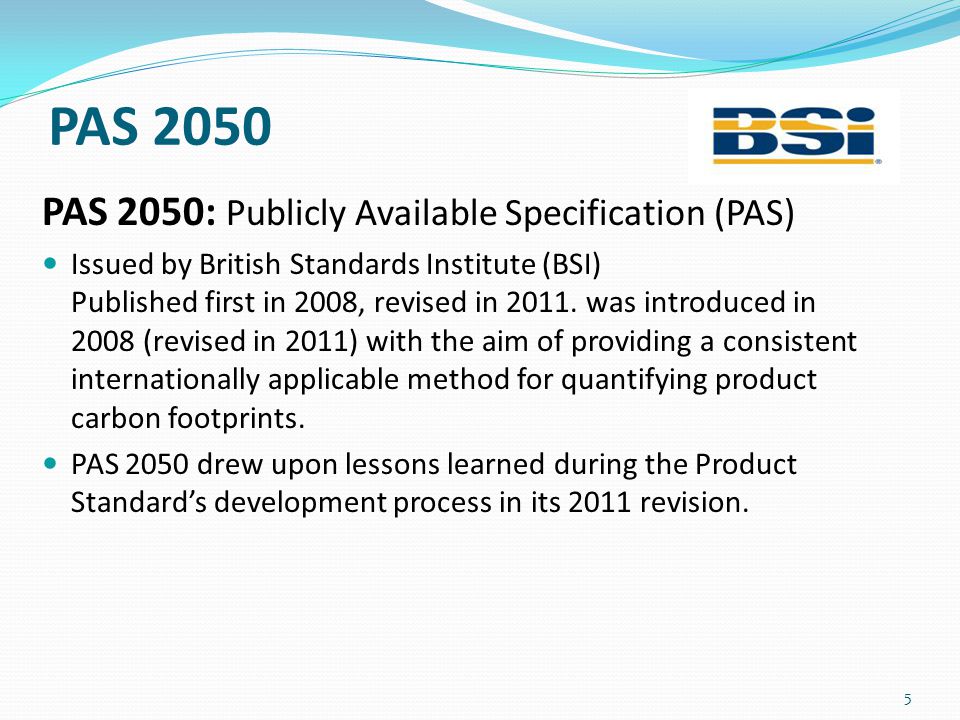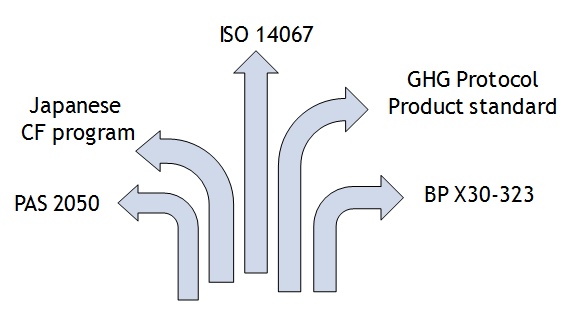The 2011 revision resulted in a standard that is largely aligned with the GHG Protocol product. PAS 2050 has already been applied by many companies worldwide and has currently been revised October 2011.
1302040 Pollution pollution control and conservation.

Pas 2050 standard. PAS 20502011 This standard PAS 20502011 Specification for the assessment of the life cycle greenhouse gas emissions of goods and services is classified in these ICS categories. The main benefits of the standard are. Standards Subscriptions from ANSI provides a money-saving multi-user solution for accessing standards.
PAS 2050 is an independent standard developed with significant input. This is increasingly key as companies and governments are moving towards a net zero world by 2050. Part of this commitment could be seen in the government.
1302040 Pollution pollution control and conservation. These requirements further clarify the implementation of these standards in relation to. The Guide to PAS 2050 page 45 suggests that embedded emissions from buildings and services might be included in a service footprint.
The English government is an active player in the drive towards reducing the worlds greenhouse emissions. PAS 2050-12012 This standard PAS 2050-12012 Assessment of life cycle greenhouse gas emissions from horticultural products is classified in these ICS categories. The Carbon Trust also created a Code It also states the companys commitment to reduce of Good Practice to standardise communications and reduction claims and the Carbon Reduction Label to.
PAS 2050 was the first carbon footprint standard and has been applied by many companies worldwide. The standard builds on existing environmental standards such as ISO 14001 and PAS 2050 which deal with the emissions of products throughout their lifespans. PAS 2050 has been developed by the British Standards BSI and came into effect in October 2008.
BS PAS 2070 2013. Arup worked with the Carbon Trust to develop PAS 2050 and the supporting documents including the Footprint Expert calculation software to ensure this standard is a comprehensive and. PAS 2050 helps to achieve the following Trada Construction Briefings 2009.
No matter what sector you operate in your organisation can use the PAS 2060 standard to strengthen relationships with customers and contribute to the long-term stability of life on Earth. PAS 2050 is the first consensus-based and internationally applicable standard on. Of PAS 2050 PAS 2050 builds on existing life cycle assessment methods established through BS EN ISO 14040 and BS EN ISO 14044 by giving requirements specifi cally for the assessment of GHG emissions within the life cycle of goods and services.
Please note that deliveries of Standards in hardcopy to Auckland maybe delayed due to Level 3 lockdown restrictions you may wish to consider purchasing your standard in a different format. BS ISO 13065 - SUSTAINABILITY CRITERIA FOR BIOENERGY. PAS 2050 - PAS 2050 was released by the British Standards BSI in 2008 as the worlds first product carbon footprint standard.
SPECIFICATION FOR THE ASSESSMENT OF GREENHOUSE GAS EMISSIONS OF A CITY - DIRECT PLUS SUPPLY CHAIN AND CONSUMPTION-BASED METHODOLOGIES. It is the only internationally recognised certification for organisational carbon neutrality. CODE OF PRACTICE FOR THE SELECTION OF WATER REUSE SYSTEMS.
Specification for the assessment of the life cycle greenhouse gas emissions of goods and. PAS 20502011 Specification for the assessment of the life cycle greenhouse gas emissions of goods and services British Standard Available for Subscriptions. PAS 2050-22012 BSI November 2012 Relationship with other GHG assessment standards PAS 2050 was introduced in 2008 revised in 2011 with the aim of providing a consistent internationally applicable method for quantifying the GHG emissions of products and services.
2013 A1 2014. PAS 2050 Specification for the assessment of the life cycle greenhouse gas emissions of goods and services mit seinen Hauptvarianten PAS 20502008 und PAS 20502011 ist eine Norm zur Bestimmung der CO 2-Bilanz eines Produkts oder einer einzelnen Dienstleistung. A specific inconsistency in the PAS 2050 documentation was identified.
Add to Alert. The Publicly Available Standard 2050 PAS 2050 was developed by the British Standards Institution in 2008 as the worlds first framework methodology for carbon footprintingThe updated 2011 version provides a method for assessing the life cycle of greenhouse gas emissions of. Publicly Available Specification PAS 2050 - Specification for the assessment of the life cycle greenhouse gas emissions of goods and services was developed by the British Standards Institution in 2008.
The specification paragraph 643 suggests that they should not. The GHG Protocol product standard has been developed by the WRIWBCSD and has been tested by 60 companies in a road test in 2010. PAS 2050 was built under consideration of British Standard BS EN ISO 14040 and BS EN ISO 14044 In order to quantifying the carbon foot print of a product service or business process during its life cycle.
Ziel von PAS 2050 ist es einen einfachen und vergleichen Standard zu schaffen um die CO 2-Bilanz verschiedener Produkte und. PAS 2060 standard provides a framework for accuracy and certification. Meeting PAS 2050 will support compliance with ISOTS 14067 in the future.
Standards as set out in PAS 2050 ISO 14040 and The Greenhouse Gas Protocol. PAS 2050 background PAS 2050 is a publicly available specification for assessing product life cycle GHG emissions prepared by BSI British Standards and co-sponsored by the Carbon Trust and the Department for Environment Food and Rural Affairs Defra. The British Standards Institution BSI has today issued a revision to PAS 2050 the standard widely used by businesses to calculate the carbon footprint of their goods and services.
Specification and publicized in Update Standards. The revised standard sponsored by Government reflects advances in theoretical knowledge and the practical experience of PAS 2050s far-reaching international user community. Standards PAS 2050 the first standard method for calculating life cycle GHG emissions of products was launched in October 2008.
As of 2011 GHG Protocol encompasses two standards that focus on life cycle GHG emissions for products and supply chains. PUBLICLY AVAILABLE SPECIFICATION PAS 20502008 Specification for the assessment of the life cycle greenhouse gas emissions of goods and services ICS code. In 2011 another product life cycle assessment method was published by the World.
UKs Product Carbon Footprint Standard PAS 2050 was published by British Standards Institution BSI in 2008 and revised in October 2011. This PAS is not to be regarded as a British Standard European Standard or International Standard.
Pas 2050 And The Carbon Top3map

Carbon Footprint Of Products Ppt Video Online Download

Product Carbon Footprint Standards Which One To Choose Pre Sustainability

Carbon Footprint Of Products Ppt Video Online Download
Objavi komentar
Objavi komentar